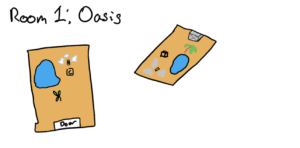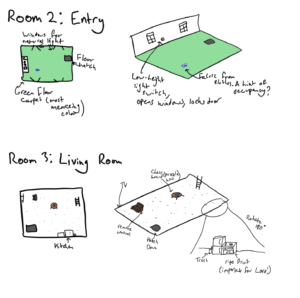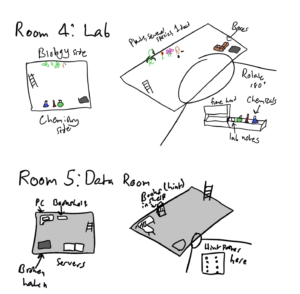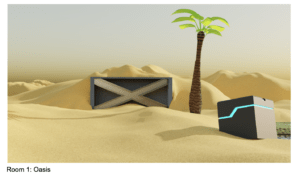Artist Statement
Sandbox is a hybrid digital/physical miniature escape room experience. Players interact with the game both through a computer terminal and via a set of boxes that represent the rooms and physical spaces that the story takes place in. Puzzles often have a digital input at their finale but feature physical/visual hints that can be uncovered by exploring the box environment.
We drew our inspiration for this game largely from text adventures and physical escape rooms. We wanted to capture the powerful and immersive narrative tools that come with video games and text adventures, as well as the intuitive and tactilely pleasing aspects of physical puzzles. Things that many games added in to simulate to evoke positive responses (dings, whirs, jingles, etc) we wanted to capture through the pleasurable feeling of being able to manipulate objects and get immediate results/feedback from your actions.
The game itself is themed as a horror/mystery, with players entering a submerged bunker-like structure of unknown origin and attempting to escape after being locked in. Along the way players discover more details about the origin and purpose of the bunker through 7 different rooms featuring 2-3 primary puzzles each.
Map
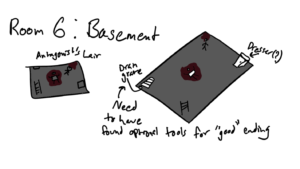
Concept Art
Initial Decisions about Formal Elements and Values
Our initial idea was to make a single player text adventure game. We wanted the player to be immersed in the story through our words and their imagination. Surprisingly, our initial in class individual brainstorming yielded similar results across the board.
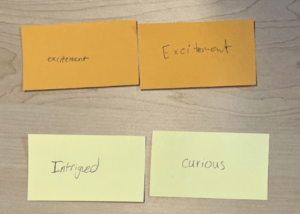 .
.
Mood – excitement, excitement, intrigued, curious
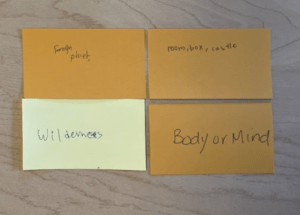
Location – foreign planet, room / box / castle, wilderness, body or mind
Based on these ideas and further brainstorming, below are the initial formal elements and values.

Theme – space, discovering / reconnecting with self, mystery / puzzle, isolation
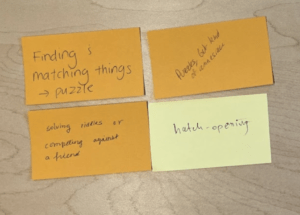
Core Mechanic – puzzle, puzzle, solving riddles / competing against a friend, hatch-opening
Target Audience: This is a game for people in search of a good narrative and mystery. We want to take the protagonist on a journey of self discovery and exploration as well as fun puzzle solving.
Synopsis: We changed the synopsis during the development process based on feedback from the team and TA. Initially, the player wakes up not knowing who they are and with no recollection of the past. They discover narrative and puzzle clues to help them understand their background and what they need to do to progress. The ending was a twist as the player learns that they killed all their allies and forgot everything so they can suppress the guilt. However, we realized that it would be difficult to insert so much narrative in a short game. As a result, the protagonist is now on a journey of self discovery (coming of age adventure) and accidentally comes across an oasis and bunker. They ultimately discover that it is a trap where the only way out is to solve all the puzzles.
Setting: This game takes place on a deserted planet. The player starts out at the desert oasis with trees and water. The oasis will be light and airy. However, the player travels to the only standing structure in sight – a bunker. The bunker is built into the ground and every floor serves a purpose. There are 5 levels/floors: entry, living room, lab, data room, and basement. The player must descend to the lowest level to unlock the mystery. The environment, mood and colors darken as the player traverses through the levels. The player’s mood changes from curiosity to anxiety to fear and ultimately hope. The mood and difficulty of the puzzle will correspond with the level that the player is on. The deeper they descend, the darker and scarier the mood, the harder the puzzle and the more they will learn about the truth of the bunker!
Players: This is a single player narrative puzzle game. Our theme is mystery and (self) exploration. We want our players to be alone, just as the protagonist is in the narrative. However, there will be other people, hints and objects in the game to help the player not feel so lonely when playing the game.
Objectives / Outcome: The primary objective is to solve different puzzles to unlock new areas and story elements. The game is largely mystery based, so puzzles and progression are both tied to and incentivized by lore drops. Completing a puzzle may yield new information that is relevant not only for later puzzles, but also for progressing story and understanding. While the first objective has a win or lose outcome, the lore objective is not zero-sum. The player should piece together the important details of the bunker as they play the game.
Resource: This is a hybrid digital-physical game. The player will interact with 1) miniature rooms that represent the different game levels, 2) physical and digital puzzles and hints, and 3) terminal for the narrative (text adventure). Hints are scattered throughout the game but players can also request hints from the moderator. Players will input solutions to puzzles in a terminal environment on a computer which will affect the physical game board via an arduino. This will mostly take the form of changing lighting to symbolize what room the player is in, revealing new hints and tools (indicated in Twine in green words) to the puzzles and some visual lore/easter eggs.
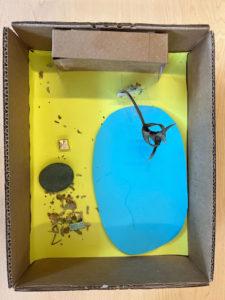
Oasis room – level 1

Data room – level 5
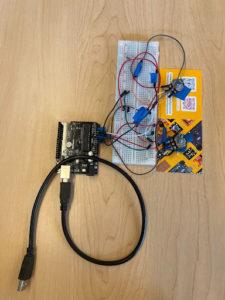
Arduino puzzle (input)
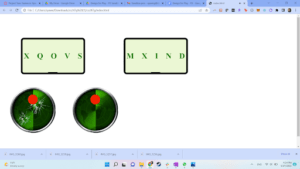
Arduino output on computer
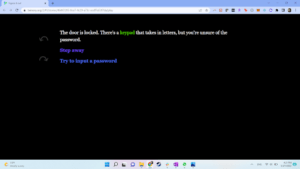
Twine hint
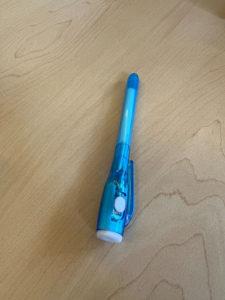
Tool – UV light pen for both rooms
Rules: There are two environments, physical room and objects/puzzles and digital narrative (room) and puzzles. Players can explore the physical objects freely and use everything presented to them to solve the puzzle. Some items and pathways will be gated until triggered by certain player actions. There is no “time” constraint or “lives” in the game.
Testing and Iteration History
Throughout weeks 7~8, we focused on testing our puzzles to make sure that the hints are helpful and the puzzles are actually doable.
Playtest 1 (testing room 2 with the binary puzzle)
- player spent 20-25 mins to decipher puzzle.
- We gave them progressively more hints, including representation, adding/subtracting, telling him it was base 2, but they still struggled with the puzzle.
- Translating from picture to algebra
- Relationships
- What’s filled vs. not filled – o or 1
- What’s the position of the filled circle – exponent from 0,1,2,3
- What’s the relationship from 1 dot to another – adding
Playtest 2 (testing room 2 with the binary puzzle)
- Player like the physical component, the prompts, and the visuals.
- They said that they prefer freeform interaction over static prompts
Playtest 3 (testing room 2 with the binary puzzle)
- Player said that the puzzles reminded them of 107
- Suggested giving hints that aren’t symmetric
- Player thought that 3 and 8 would be more helpful as the binary hint
- They suggested giving 1 with only 1 dot
Iteration: After this playtest, we decided to use 7 and 1 as examples for the binary puzzle to provide a better hint
Playtest 4 (testing room 2 with the binary puzzle with a changed hint – using 7 and 1 as an example)
- The tester didn’t want hints
- Solved the puzzle immediately
- They started enumerating bring “0010 is 4”
- Paper helped
- wrote all 40bit binary combos up to 16
- Read upside down
- We were able to see that the new hint was
Playtest 5 (testing room 2 with the binary puzzle with a changed hint – using 7 and 1 as an example)
- This tester also said that it is “an easier CS experience”
- Their immediate guess regarding the binary puzzle was 4 dots
- Maybe have a binary note nearby to prime the targets?
- They were confused to make the jump from 7 to 8
- They suggested using basic equations as hints
Iteration: After this playtest, we decided to use 7 + 1 = 8 as examples for the binary puzzle to provide a better hint. We also highlighted important words in Twine in green to make sure to catch players’ eye.
Playtest 6 (testing room 1 and room 2)
- Had to be guided to look at the box
- Place the box next to the computer and make sure to tell them before hand
- Solved first room in about 5 minutes
- Initial thoughts
- Thought it was cool
- There was a point that we handed the black light so he knew that it was gonna be needed
- Maybe introduce the black light in the beginning because it makes it too obvious that you are gonna need the black light will be needed
- Make sure to make it obvious if people get it wrong
- Said he’s more of a doer than a reader
- He will read only if the passages organically peak his interest
- Make it so that if he hadn’t read it, he can’t exit
- So maybe we can use timed buttons
- Interacting with the box and computer feels disjointed
- Part in the terminal that felt strange
- Even though you are moving in the text, you are not moving the box
- Part in the terminal that felt strange
- Had to be guided to look at the box
- Place the box next to the computer and make sure to tell them before hand
- Solved first room in about 5 minutes
- Second room
- We had to change computers as it was not fully integrated with the first room yet
- Ruslan explained how to control the move
- The puzzle glitched oops
- The tester asked a few confirming questions about the puzzle structure
- “Not sure im supposed to fill in this question mark”
- “What did i even accomplish?”
- Had to draw out the binary puzzle to solve it
- Paper is still helpful
- Thoughts:
- Confused about the puzzle
- He likes it but problems with control
- He still thought the room/idea was cool
- He liked that the game is more about the control and coordination
Iteration: We added extra hints in the books in the second room for the binary puzzle. These hints can be seen using the black light that the players are given in the first room.
Throughout the past palytests, we continued to alter the narrative on Twine and its structure to reflect all the small feedback we received. After playtest 6, we made sure to change Twine to fix the disconnect between the virtual and physical components. Additionally, using feedback from playtest 6 that it is hard to know when you get something wrong and whether you can retry the puzzle that you failed to solve the first time, we changed some frames that used to say that the input was wrong to rather tell people to go back and try again. This change was to reflect that even if you get something wrong, you can always retry until you get the puzzle.
Playtest 7
- Tyler to explain the basics of text adventure
- Something to take into account when making walk throughs as some people might not be familiar with text adventure format games
- The tester looked through the box attentively in the beginning of the game
- Tyler had to make a clarification because the chest mentioned in the text adventure doesn’t look like a chest
- She thought it was the clue because it was a folded piece of paper
- This was due to the limitation of budget and time rather than the actual structure of the game
- She thought it was the clue because it was a folded piece of paper
- As in playtest 5, we gave the black light once she solved the first question
- We could adjust the difficulty by giving the black light in the beginning
- Found the black light clue pretty quickly
- She thought the word would be something that she would know
- But this was a handwriting problem
- She seemed to be reading all of the texts
- Whether a player reads the texts or not is truly dependent on the type of people they are
- She really liked the first room
- different components were really enjoyable
- Fun one person challenge
- Kept saying it was a good challenge
- Would’ve been better with more or less options in exploring?
- Like previous testers, she also said that it was clear that there was only one path that you “had” to take
- Happy to try the second room
- Second room
- Looking around a lot, looking for clues, little lost
- Had to be instructed to turn the box around
- Second puzzle
- First guess
- Having hard time realizing the binary number puzzle
- I think white and black can be confusing
- Kind of realized the mechanism but didn’t really get that it is binary
- Expressed it as you carry this here, etc
- Something to take into consideration
- Didn’t want to give up even though it was taking a long time
- First guess
- Was really excited when she solved the problem
- The knobs are too delicate
- Wasn’t able to really playtest
- She also really liked the second puzzle
- Again, she enjoyed the mixture of physical and virtual components!
Playtest 8
- He said, “that’s kinda sick”
- He pointed out that there is nothing to make sure that players read the dialogues
- He solved the first room in like 2 minutes
- He thought the game was pretty straightforward
- Anyone could pick it up
- He thought the game was pretty straightforward
- We really need to glue everything so that time doesn’t get wasted trying to keep things together
- Confused about the binary puzzle
- Either need to make the puzzle description more clear
- He started randomly guessing
- Didn’t really understand the third puzzle
- Looking around the room a lot
- Then, started figuring out binary
- Silent, contemplative
- “I think it was fun”
- “I think it will be a lot easier if i remembered 107”
- “I like that there is a lot of random texts”
- “It’s clear what is necessary to move on to the next steps”
- Would’ve preferred having more options to explore or room for creativity/individuality
- Besides that everything was fine
Playtest 9
- Had a lot of trouble with the last puzzle
- Couldn’t finish it
- Looked really frustrated and annoyed at the end
- The puzzle was too finnicy
- She thought the puzzle was really cool, creative, and awesome
- She found the background and navigating between things was challenging
- Understanding how things go where conceptually in the head was difficult
- Too much stuff going on
- Plot was interesting
- Too much text -> didn’t wana read
- She said that the texts were rather wordy
- Favorite part: design, black light thing, puzzle’s good but maybe not for people who are not mathematically strong
- Least favorite part: third puzzle
Click here for some final playtest videos
Separate playtests for Arduino puzzle:
1:
-One of the two players spent quite some time trying to rotate the potentiometers all the way through
-Both players exclaimed about how sensitive the controls were
-Both players thought the concept was cool
-> fixes: added filtering to make controls less sensitive, experimented with hardware filters as well but stuck to software. Also scaled up controls to fit full rotation of a circle (~270 -> 360).
2:
-Player said game is glitchy
-No complaints about the rotation scale by the player
-Was too easy to guess the word
-> fixes: tried to mediate the glitchiness even further with resistors and more software adjustments, refined the zone of rotation to require more intentional rotations (i.e., require more accuracy)
3:
-Tester said game is “moderately glitchy” (2-3/5) but still doable and does not affect gameplay
-Tester wanted the game to use some other cues that would guide the player into getting the right answer (thought that getting the right rotation was slightly difficult/frustrating)
-> fixes: soldered and taped some of the wires in an attempt to reduce how janky the controls are, found sweet spot for the range of values needed to get the right answer
4+5 (resolutions/fixes):
-Redesigned output indicator to be a box and differentiated between controls (circles) and the cipher (boxes).
-Leaned into the jankiness of the puzzle by photoshopping one of the control panels to be broken.
-Added 3 different sound clips (cold, slightly warm, hot) to indicate distance from being close to the answer to help guide the players to the answer.
-Transposed one of the clips a pitch up to distinguish both controls.
Future iterations
- Make sure that passwords get locked in on Twine once players get it correct
- Remove the undo button on Twine and make it possible to loop back to previous options instead
- Embed the binary and arduino puzzles into twine directly by changing from the Harlowe Twine engine to Sugarcube for an improved connection between every component of the game – twine, puzzles, physical rooms.
- Convert stereo audio for arduino puzzle into mono and pan the audio for the left puzzle through the left speaker and the right one through the right speaker.
- We don’t plan on changing the physical room or the puzzle component as that comes withl limitations in time, fund, and portability.
Playtest conclusion
At this point, we were able to identity the common feedback among the playtesters
- Most testers really liked having a physical box and text adventure
- They said it was fun and creative
- We were happy to see that players experienced the fun that we intended for them to experience
- Binary puzzles took testers either 3 minutes or 30 minutes to solve
- Everyone had different interpretations or preference on how the circles should be filled or left blank to express binary numbers
- We changed the hints so that players with less math or cs backgrounds could participate
- We also added a second way (hint pops up after 1 min) to solve the puzzle, utilizing the UV light they collected from Oasis 1. This method required no math skills and some trial and error
- The texts were long and many identified that there really isn’t a way to ensure that players read all of the texts
- Some suggested that we make it more organically intriguing rather than putting in measures to enforce reading
- Third puzzle is cool but rather finicky
- The room could’ve turned out a bit better if it wasn’t for limitations in funds and time
- There was a bit of dissonance between what was going on in the text and the given rooms
- You are “moving” in the text but you are still looking at the same room
- The “chest” where you are supposed to get the black light from doesn’t look like an actual chest and we had to hand the black light manually.
Post-morterm
If we were to continue working on this in the future, one thing that we want to put a big emphasis is on making sure that the physical components are sound and of a correct scale. We are pretty satisfied with our narrative. However, we feel that our rooms don’t do the perfect job in representing the story; therefore, we would like to perfect the physical components, including the third puzzle. Additionally, we would like to conduct even more playtests to survey what the best way to represent binary numbers is so that players without math or science backgrounds could also easily spot the pattern and partake in the puzzle. Lastly, we would like to sync some physical components in rooms to represent what is happening in the narrative. Something that we discussed was having a chest that looks like an actual chest holding a black light that automatically opens when the player solves the puzzle. That way, we can introduce the black light more organically and make sure that the players are absorbed into each step of the game.
Videos
Gameplay Explanation Videos: https://drive.google.com/drive/folders/1odV8p1hVfwgBgE4WR-8v6WKIsHC-SnPW?usp=sharing
- Sandbox Intro: game concept explanation
- Sandbox – Oasis: walkthrough of Oasis Room and first 2 puzzles
- Sandbox – Data 1: walkthrough of Data Room
- Sandbox – Data 2: walkthrough of Data Room Binary puzzle solution 1
- Sandbox – Data 3: walkthrough of Data Room Binary puzzle solution 2 and Arduino puzzle
Other Game Playtest Feedback
Game Name:Escape From Your Mind
Tester: Sophia Weng
Escape From Your Mind is a team escape room game. I tested 2 puzzles with another player – the first was a riddle and the second a logic question. The first puzzle required the player to figure out a 4 digit combination from a poem, clues in the escape room (given to us for the sake of testing) and 9 clock faces with different times. We solved the majority of the puzzle really quickly because the poem was very straightforward. However, we were stuck at the end because the final step from the poem wasn’t as specific as other parts of the puzzle. We needed to use arithmetic to find the 4 digit combo, but it wasn’t clear if we were supposed to add the hours and minutes separately or together (e.g., hour + hour + hour vs hour + minute). We defaulted to the first method since that made the most sense. However, we learned that the right answer was the letter method and most testers also defaulted to our method. Our feedback to the team was to make the poem more straightforward or change the answer to the more common answer.
The logic game we tested was really fun and took less than 10 minutes to complete because we both love logic puzzles. There was a small typo in the text that was confusing but really addressed. The core of the game was to match 3 people to 3 activities and 3 shadows. Once matched, the players need to use the number of letters from these words to perform arithmetic for another set of digit combo. Unfortunately, a lot of the names and letters had similar digits (lots of 5), so it was very easy to “game” the puzzle. There was a division operation and since the result needed to be a whole number, players can also back into the puzzle. Ultimately, the puzzle solving was fun, but less satisfying once we realized that we could derive the combo through “hacks.”
Game: Locked Door Office Hours
Tester: Sophia
This is a multiplayer escape room and I played with 3 other testers. The first puzzle is a drawing involving ohm’s law (physics) and formula. It was quite daunting at first since none of us remembered how to do physics. We struggled for 5 minutes until the moderator told us to look at the bigger picture. We then realized that the answer was right in front of our eyes. The 4 digit was drawn out in graphic of the circuit demonstrating ohm’s law. I thought this was pretty cool since we solved it without having prior / outside knowledge.
The second puzzle was watching a video recording and answering questions based on details of the video. It was hard to hear the audio since the music was too loud and it was hard to hear words since actors weren’t enunciating. We got all the questions correctly, but this puzzle didn’t feel challenging or satisfying at all. I also noticed that it would be easy for other team members to tune out. This wasn’t as collaborative as I wanted it to be.
Game: Escape from Z-Industries, Inc.
Tester: Ruslan
Escape from Z-industries, Inc. is a captivating single player escape room experience that has you, a patient who signed up for a research study, escape from a doctor’s office/lab. Off the bat, the game wastes no time and just throws you straight into action. Right after hearing a scream that comes from outside the room, the assistant runs out of the room and leaves the door locked behind them, leaving you all alone and creating quite the mysterious atmosphere. In order to escape, you are taxed with figuring out the input to the keypad that unlocks the door.
In the first puzzle, you’re faced with unlocking a random box by looking through a miniature zen garden for the keys. After unlocking the box, you find a black light alongside a sticky note with a laptop’s password which leads you to the second puzzle. The sticky note, however, was only partially filled in (c _ _ _ [space] _ _ e _ _ _).
After looking around for clues by shining the blacklight on random items in your surroundings, you notice the fingerprints on the laptop’s keyboard. Upon further inspection, some of the keys have prints in two different parts, indicating that the key was pressed more than once. After writing down all the different possible letters, you can seek further hints (with phrases such as “Sanitize your soul”) from looking at the laptop’s lock screen. Guessing the right word grants you access to the laptop where you find the folder “Classified” with a bunch of folders with different, seemingly random, words and phrases that span multiple levels deep. By looking around, you can find the wall plastered with a bunch of phrases and emojis. By matching what’s on the wall and the directory names, you finally find a pdf with the patient’s information, including the patient number which you use to unlock step 1 of the keypad. Step 2 requires you to unlock a swipe-to-unlock interface (similar to what Android phones use) to which the solution requires you to have noticed the Z logo on the computer’s wallpaper.
Overall, I would say this was one of the most fun escape room experiences I have personally had. I found myself in awe as I was solving through the different puzzles in response to how creative and different all the puzzles were. I think something that would have enhanced my experience would have been the inclusion of some sort of auditory aspect of the game. I feel like even some sort of soundtrack that plays in the background would have made my experience slightly more immersive.


